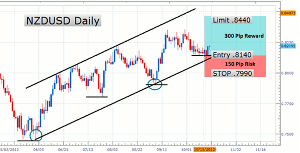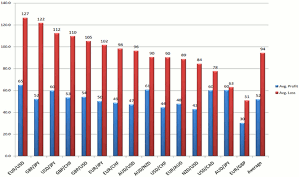Walker England of DailyFX.com explains how to set up a solid exit strategy before you get caught up in the excitement of a trade.
More often than not, traders that are new to markets will primarily focus on ways to enter into trades. This is logical since trading is exciting and it can be difficult at first to resist the emotional siren song of the market. While entering trades is definitely important, most experienced traders will agree that having a clear trading plan and knowing how to exiting a trade will have a greater impact on a trader’s long-term profit and loss total. With today’s trading lesson, we will be focusing on exiting positions using a positive risk reward ratio.
A risk reward ratio refers to the practice of identifying how many pips we wish to gain in profit relative to what we are risking in the event of a loss. Using this concept is one of the most straightforward ways to exit a trade because stop and limit order placement is decided prior to a trade entering into the market. By deciding where your stops and limits will be placed prior to entering the market, there will be no debate in regards where a trader plans to exit. Let’s look at an example.
Above we have the NZDUSD daily graph with a trade setup mentioned in a previous edition of Trend of the Day. In this example, traders are looking to buy an upward pricing channel with entries near .8140. Limit orders look to take 300 pips in profit, if the trade idea works out. Losses are set to be cut to 150 pips of risk at .7990 if our stop order is executed. This is an example of a 1:2 risk reward ratio, as we are looking to make twice as many pips in profit as we are willing to assume in a loss. The key is to set these values prior to entering into the market and then use a positive risk reward ratio.
Ultimately using a positive risk reward ratio is designed to help traders avoid the #1 mistake forex traders make. Through extensive research, quantitative strategist David Rodriguez was able to identify that on virtually every pair, traders were taking larger losses when they were wrong relative to the amount they made when trades were closed for profit. This can become a potential problem for traders as a very high winning percentage will be needed to compensate for the much higher losses. By using a positive risk reward ratio, traders can flip this statistic in their favor by allowing traders to maximize their profits when they are right and limit their losses when a trade moves against them.
Walker England is a trading instructor at DailyFX.com.




















